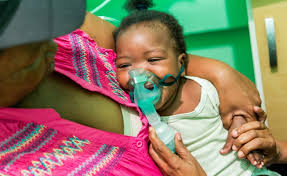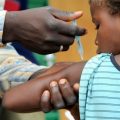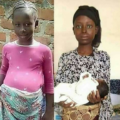What is Pneumonia?
Pneumonia is a form of acute respiratory infection that affects the lungs. The lungs are made up of small sacs called alveoli, which fill with air when a healthy person breathes. When an individual has pneumonia, the alveoli are filled with pus and fluid, which makes breathing painful and limits oxygen intake.
Pneumonia is the single largest infectious cause of death in children worldwide. Pneumonia killed 808 694 children under the age of 5 in 2017, accounting for 15% of all deaths of children under five years old. In Nigeria, 19% of child deaths were due to pneumonia in 2018, and it was the biggest killer of children under-five in 2017. There are an estimated 56 million episodes of lung infections among Nigerian children every year. Although, not all episodes will lead to death, these infections nevertheless cause suffering and require treatment. Pneumonia is an economic burden for families and communities, contributing to the cycle of poverty. Pneumonia affects children and families everywhere, but is most prevalent in South Asia and sub-Saharan Africa. Children can be protected from pneumonia, it can be prevented with simple interventions, and treated with low-cost, low-tech medication and care. READ: Is Peak 123 Milk Good for Babies ?
What Causes Pneumonia
Pneumonia is caused by a number of infectious agents, including viruses, bacteria and fungi. The most common are:
- Streptococcus pneumoniae – the most common cause of bacterial pneumonia in children;
- Haemophilus influenzae type b (Hib) – the second most common cause of bacterial pneumonia;
- respiratory syncytial virus is the most common viral cause of pneumonia;
- in infants infected with HIV, Pneumocystis jiroveci is one of the most common causes of pneumonia, responsible for at least one quarter of all pneumonia deaths in HIV-infected infants.
How Pneumonia is Transmission
Pneumonia can be spread in a number of ways. The viruses and bacteria that are commonly found in a child’s nose or throat, can infect the lungs if they are inhaled. They may also spread via air-borne droplets from a cough or sneeze. In addition, pneumonia may spread through blood, especially during and shortly after birth. More research needs to be done on the different pathogens causing pneumonia and the ways they are transmitted, as this is of critical importance for treatment and prevention.
Presenting features of Pneumonia
The presenting features of viral and bacterial pneumonia are similar. However, the symptoms of viral pneumonia may be more numerous than the symptoms of bacterial pneumonia. In children under 5 years of age, who have cough and/or difficult breathing, with or without fever, pneumonia is diagnosed by the presence of either fast breathing or lower chest wall indrawing where their chest moves in or retracts during inhalation (in a healthy person, the chest expands during inhalation). Wheezing is more common in viral infections. Very severely ill infants may be unable to feed or drink and may also experience unconsciousness, hypothermia and convulsions.
- a cough – which may be dry, or produce thick yellow, green, brown or blood-stained mucus (phlegm)
- difficulty breathing – your breathing may be rapid and shallow, and you may feel breathless, even when resting.
- rapid heartbeat.
- high temperature.
- feeling generally unwell.
- sweating and shivering.
Risk factors
While most healthy children can fight the infection with their natural defences, children whose immune systems are compromised are at higher risk of developing pneumonia. A child’s immune system may be weakened by malnutrition or undernourishment, especially in infants who are not exclusively breastfed.
Pre-existing illnesses, such as symptomatic HIV infections and measles, also increase a child’s risk of contracting pneumonia.
The following environmental factors also increase a child’s susceptibility to pneumonia:
- indoor air pollution caused by cooking and heating with biomass fuels (such as wood or dung)
- living in crowded homes
- parental smoking.
How Pneumonia is treated
Pneumonia is treated with antibiotics. The antibiotic of choice is amoxicillin dispersible tablets. Most cases of pneumonia require oral antibiotics, which are often prescribed at a health centre. These cases can also be diagnosed and treated with inexpensive oral antibiotics at the community level by trained community health workers. Hospitalization is recommended only for severe cases of pneumonia.
How to prevent Pneumonia
Preventing pneumonia in children is an essential component of a strategy to reduce child mortality. Immunization against Hib, pneumococcus, measles and whooping cough (pertussis) is the most effective way to prevent pneumonia.
Adequate nutrition is key to improving children’s natural defences, starting with exclusive breastfeeding for the first 6 months of life. In addition to being effective in preventing pneumonia, it also helps to reduce the length of the illness if a child does become ill.
Addressing environmental factors such as indoor air pollution (by providing affordable clean indoor stoves, for example) and encouraging good hygiene in crowded homes also reduces the number of children who fall ill with pneumonia.
In children infected with HIV, the antibiotic cotrimoxazole is given daily to decrease the risk of contracting pneumonia.
What is the economic costs of Pneumonia?
The cost of antibiotic treatment for all children with pneumonia in 66 of the countdown to 2015 countries for maternal, newborn and child survival is estimated at around US$ 109 million per year. The price includes the antibiotics and diagnostics for pneumonia management.
Pneumonia is a problem with solutions
We can protect children from pneumonia and many other diseases through exclusive breastfeeding during the first 6 months of life.
In Nigeria, only 20% of babies are exclusively breastfed, this needs to be improved. Other strategies to protect include: good nutrition, hand‐washing, and reduced indoor air pollution.
We can prevent pneumonia with new and effective vaccines against HiB and pneumococcus. With help from GAVI, many countries in Africa now provide or will soon provide the HiB vaccine. A pneumococcal conjugate vaccine has already been introduced in Rwanda, The Gambia, and South Africa.
Thanks to a new and clever way to fund vaccines called the Advance Market Commitment (AMC), more low‐income countries will soon have access to this new generation vaccine. The Nigerian government is striving to include HiB and pneumococcal vaccines into the national immunization program with GAVI’s support.
Other preventive strategies include: vaccination against measles and pertussis (i.e. whooping cough), zinc supplementation, HIV prevention, and antibiotic prophylaxis for people with or exposed to HIV
Children should have access to effective and affordable treatment. Treatment for most types of serious pneumonia is usually antibiotics, which typically cost less than 150 Naira per dose.
Effective case management strategies can help to ensure that children receive the right treatment for pneumonia quickly.
In Nigeria, only an estimated 1 of every 5 children with pneumonia receives appropriate antibiotics.
Health policies and services should be designed to provide children prompt and effective treatment for pneumonia.
Raise awareness about pneumonia among leaders and health providers Educate the public to recognize pneumonia and seek proper treatment





